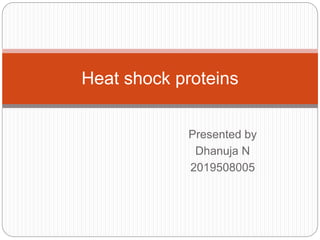
HEAT SHOCK PROTEINS
- 1. Presented by Dhanuja N 2019508005 Heat shock proteins
- 2. Stress Plants interact with not only climatic factors (such as irradiation, temperature, and drought) but also soil factors (such as salinity) and biotic factors (such as herbivores and pathogens). All these factors put the plant under interrelated stresses. Plants could not change their sites to avoid such stresses, but have different ways and morphological adaptations to tolerate these stresses
- 3. What happens during stress? Proteins are the major components of living organisms and perform a wide range of essential functions in cells. The activity of a protein depends on its 3D structure. Intramolecular bonds, especially hydrogen bonds, maintain the structure. Hydrogen bonds may break when the pH drops or the temperature rises above normal denaturing the protein.
- 4. Heat-shock proteins Heat stress as well as other stresses can trigger some mechanisms of defense such as the obvious gene expression that was not expressed under “normal” conditions. The sudden changes in genotypic expression resulting in an increase in the synthesis of protein groups. These groups are called “heat-shock proteins” (Hsps), “Stress-induced proteins” or “Stress proteins”
- 5. Heat-shock proteins Heat shock proteins (HSPs) are ubiquitous proteins found in plant and animal cells. They originally were described in relation to heat shock (Ritossa, 1962) in Drosophila but are now known to be induced by a wide variety of stresses, including exposure to cold, UV light, wound healing, tissue remodeling, or biotic stresses. Synthesis of these proteins is energy costly.
- 6. Hsp classification In plants, there are five principal classes of Hsps characterized by their activities as molecular chaperones according to their approximate molecular weight 1. HSP100 2. HSP90 3. HSP70 4. HSP60 (chaperonin) 5. Small Heat Shock Proteins/ (alpha)-crystalline proteins
- 7. Hsps of prokaryotes and eukaryotes Escherichia coli Eukaryotic cells ClpB Hsp100 HtpG Hsp90 Dnak Hsp70 GroEL Hsp60
- 8. Functions
- 10. Heat stress transcription factors Differenent classes of genes code for these proteins. The transcription of these genes is controlled by regulatory proteins called heat stress transcription factors (Hsfs) located in the cytoplasm in an inactive state. Each factor has one carboxylic terminal (C- terminal) and three amino terminal (N-terminal) and has the amino acid leucine.
- 11. These factors have been classified into three classes Plant HsfA such as HsfA1 and HsfA2 in L. esculentum Plant HsfB such as HsfB1 in L. esculentum Plant HsfC In the absence of stressing factors, Hsfs are present in the cytoplasm as single and free as there is no binding activity with DNA, but when stress starts the factors aggregate in triplet and accumulate in the nucleus
- 12. Upregulation in stress During heat stress, outer membrane proteins (OMPs) do not fold and cannot insert correctly into the outer membrane. They accumulate in the periplasmic space. These OMPs are detected by DegS, an inner membrane protease, that passes the signal through the membrane to the sigmaE transcription factor. However, some studies suggest that an increase in damaged or abnormal proteins brings HSPs into action.
- 13. sHsps 8-24 monomer. Exhibit chaperone activity in vitro and thermoprotection in vivo. Produced at significant levels in cells under heat stress. Most are heat inducible, but some are synthesized in unstressed conditions-such as for cell development. Activity is independent of ATP. Degradation of proteins that have unsuitable folding by ubiquitination.
- 14. Hsp60 Chapronins 14-16 monomer ATP Mediate the native folding of proteins through cooperation of HSP70 and 60 Mediate folding and prevent aggregation of proteins transported to chloroplast and mitochondria.
- 15. Hsp 70 Monomer ATP Assists in protein transport into mitochondria and the endoplasmic reticulum Protects PS II during photoinhibition Stabilizes proteins prior to complete folding Transports across membranes and proteolysis
- 17. Hsp 90 Dimer ATP Stabilizes proteins prior to complete folding or activation Forms stable complexes with inactive glucocorticoid receptor and other Most abundant non-ribosomal protein (cytosolic version) Most abundant protein in endoplasmic reticulum (ER version)
- 18. Cytoplasmic Hsp90 is responsible for pathogen resistance by reacting with resistance protein (R) which is the signal receptor from the pathogen. Hsp90 was an essential component of innate- immune response and pathogenic resistance in rice.
- 19. Hsp 100 6-7 monomer ATP No co-chaperon is required Functions Solubilizes protein aggregates thereby dissociating them Facilitates proteolysis Essential in yeast for acquired thermotolerance Essential for yeast prion propagation
- 20. Hsp Families Cellular location Proposed functions Hsp27 (sHsp) Cytosol, nucleus Microfilament stabilization, antiapoptotic Hsp60 Mitochondria Refolds proteins and prevent aggregation of denatured proteins, proapoptotic Hsp70 Antiapoptotic • Hsp72(Hsp70 ) Cytosol, nucleus Protein folding, cytoprotection • Hsp73(Hsc70 ) Cytosol, nucleus Molecular chaperones • Hsp75(mHsp 70) Mitochondria Molecular chaperones • Hsp78(GRP7 8) Endoplasmic reticulum Cytoprotection, molecular chaperones Hsp90 Cytosol, endoplasmic Regulation of steroid hormone receptors, protein
- 21. Why Don't Heat Shock Proteins Denature? Better Hydrogen Bonds Better Hydrophobic Internal Packing Enhanced Secondary Structure Helix Dipole Stabilization
- 22. Conclusion The expression of Hsps could occur in natural environment. The hsp genes are found in all species but they vary in patterns of expression. The expression of Hsps could be correlated with resistance to stress. The threshold of species for Hsps expression are correlated with the strength of stress prevailing in the environment.
- 23. References Chang-Jin Park and Young-Su Seo, Heat Shock Proteins: A Review of the Molecular Chaperones for Plant Immunity, Plant Pathol J. 2015 Dec; 31(4): 323–333. Mohamed H.Al-Whaibi, Plant heat-shock proteins: A mini review, Journal of King Saud University – Science, Volume 23, Issue 2, April 2011, Pages 139-150. https://en.wikipedia.org/wiki/Heat_shock_protein https://www.ncbi.nlm.nih.gov/pubmed/18432918